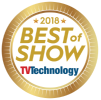
How COVID-19 Pandemic Pushed the Use of Remote and Cloud Services in TV
Viewers’ appetites have increased for live TV news and streaming entertainment due to COVID-19 isolation. So, it would seem almost impossible for broadcasters and content providers to keep up with demand by working from home. Yet, the advent of digital technology has gradually turned some production studios and master control rooms into nearly vacant warehouses. It’s been said that ‘necessity is the mother of invention’ and in the case of media content providers, it’s been the incentive for them to adapt full-time to innovative technologies during the COVID-19 pandemic.
The implementation of digital technology becomes obvious when newscasters can seamlessly deliver the news from their personal kitchens and living rooms like Today Show hosts Savannah Guthrie and Al Roker recently have.
But what about all the behind-the-scenes aspects of production? The capabilities for reviewing footage, editing, color grading, adding graphics and audio post-production have gradually been shifting to remote services and in the cloud. Cloud-based platforms for creating, producing, editing and distributing content have allowed media companies to experience better scalability and performance.
Fortunately, the broadcast and content distribution industry has benefited from improved IP connectivity and automated software whether they were using it at full scale or not. Content providers must rely on those technologies more than ever now that their employees are working from home.
The main concerns that organizations have about allowing employees to work from home include secure file transfers, appropriate software licenses and of course, collaboration tools among team members.
After considering the management of talent, content and distribution, monitoring for quality and compliance might be thought of as the last hurdle. Qligent has been working with our customers to help them establish business continuity models and take full advantage of all remote monitoring features that our Vision platform offers so that they can use these tools to work from home and reduce in-plant presence. We’ll get through this together.









